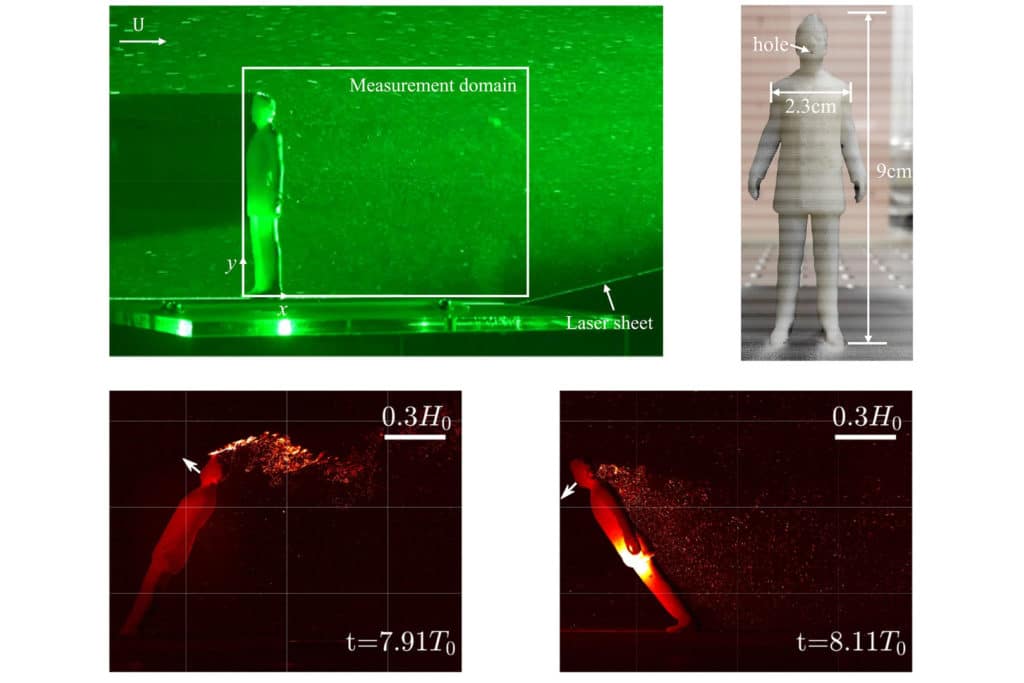A global pandemic infectious respiratory disease, coronavirus disease 2019 (COVID-19), threatens human life and health. Since the outbreak of COVID-19, fluid droplets expelled from the respiratory tract have attracted much attention because the dispersion of the infectious virus in droplets generated by talking, coughing, and sneezing is one of the significant routes of virus transmission.
Healthy persons may become infected by inhaling airborne droplets of the virus with even a short exposure. Therefore, it is critical to understand droplet transmission under different typical flow conditions in real life for modeling and controlling the epidemics.
Researchers describe the dispersion of cough-generated droplets from people as they walk up and downstairs. In AIP Advances, by AIP Publishing, Hongping Wang and his team show models driving how respiratory droplets fell from a mannequin inside a water tunnel, inclined at different angles to mimic a person going up and downstairs.
“Two different patterns of droplet dispersion are observed due to the different wake flows,” said Wang. “These results suggest that we should cough with the head down toward the ground to ensure that most of the droplets enter the wake region.”
The group 3D-printed mannequins using white resin, each with a different inclination angle, represents the leaning that we naturally do when going upstairs and the leaning back when we walk down.
After placing each mannequin in the water tunnel, they introduced hollow glass microspheres into the tunnel. When illuminated by lasers, the glass microspheres provided a way to visualize the flow motion behind the mannequins. This flow field, often called a wake, was studied using particle image velocimetry.
In computer simulations, particles lower than the head and moving toward the ground became caught in each mannequin’s wake and moved downward. It appeared particles above the head could move relatively far distances horizontally as if they were emitted from the top of the head.

For the mannequins whose inclines reflected going upstairs, particles concentrated below the shoulder and moved downward with a short travel distance. For simulating going down, particles dispersing over the person’s head were carried for a long distance.
“The major challenge is how to use particles in water to simulate the droplets in the air,” Wang said. “The most surprising part was that the particles higher than the head can travel a much longer distance than those particles lower than the head due to the induction of the wake flow.”
Wang wants to study the 3D effects of real people coughing while walking in experimental conditions.
Based on the findings in this study, researchers provided the following recommendations.
- Considering the environment and scenario, a greater social distance is suggested for people going downstairs or riding descending escalators.
- A proper and polite coughing posture is essential to prevent airborne transmission. The World Health Organization suggests covering the mouth and nose with a bent elbow or tissue when coughing or sneezing. It is also critical that a person on an escalator cough or sneeze with the head down toward the ground so that the dispersed droplets (escaping from the blockage of the elbow or the tissue) are entrained into the wake region toward the ground. This may reduce the probability of droplets being inhaled by a person following behind.
- In contrast to droplet dispersion in the steady flow field, unsteady airflow fluctuations can result in the clustering of droplets. A high concentration of droplets slows down the dispersion of the droplets toward a safe local concentration level and correspondingly increases the distance of droplet dispersion with safety concerns. This nontrivial effect should be considered in evaluating the dispersion of droplets in real cases.
Journal Reference
- Hongping Wang, Zhaobin Li, Yi Liu,Lixing Zhu, and Zhideng Zhou; Experimental study of the dispersion of cough-generated droplets from a person going up or down stairs. AIP Advances 12, 015002 (2022); DOI: 10.1063/5.0073880
